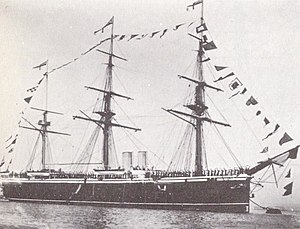
HMS Australia was one of seven Orlando-class armoured cruisers built for the Royal Navy in the mid-1880s. She was assigned to the Mediterranean Fleet in 1889 and remained there until 1893 when she returned home. The ship was assigned to the Coast Guard Squadron for the next decade before she was placed in reserve in 1903. Australia was sold for scrap in 1905.

HMS Devastation was the first of two Devastation-class mastless turret ships built for the Royal Navy. This was the first class of ocean-going capital ship that did not carry sails, and the first whose entire main armament was mounted on top of the hull rather than inside it.

HMS Dreadnought was an ironclad turret ship built for the Royal Navy during the 1870s. Construction was halted less than a year after it began and she was redesigned to improve her stability and buoyancy. Upon completion in 1879, the ship was placed in reserve until she was commissioned in 1884 for service with the Mediterranean Fleet. Upon her return 10 years later, she became a coast guard ship in Ireland for two years. The ship then became a depot ship in 1897 before she was reclassified as a second-class battleship in 1900. Dreadnought participated in the annual fleet manoeuvres for the next two years before she became a training ship in 1902. The ship was taken out of service three years later and sold for scrap in 1908.

HMS Galatea was one of seven Orlando-class armoured cruisers built for the Royal Navy in the mid-1880s. She was sold for scrap on 5 April 1905.
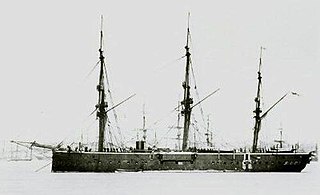
HMS Audacious was the lead ship of the Audacious-class ironclads built for the Royal Navy in the late 1860s. They were designed as second-class ironclads suitable for use on foreign stations and the ship spent the bulk of her career on the China Station. She was decommissioned in 1894 and hulked in 1902 for use as a training ship. The ship was towed to Scapa Flow after the beginning of the First World War to be used as a receiving ship and then to Rosyth after the war ended. Audacious was sold for scrap in 1929.

HMS Collingwood was the lead ship of her class of ironclad battleships built for the Royal Navy during the 1880s. The ship's essential design became the standard for most of the following British battleships. Completed in 1887, she spent the next two years in reserve before she was assigned to the Mediterranean Fleet for the next eight years. After returning home in 1897, the ship spent the next six years as a guardship in Ireland. Collingwood was not significantly damaged during an accidental collision in 1899 and was paid off four years later. The ship was sold for scrap in 1909 and subsequently broken up.

HMS Anson was the last of six Admiral-class ironclad battleships built for the Royal Navy during the 1880s. The ship was completed, except for her armament, in 1887, but had to wait two years for her guns to be installed. She was assigned to the Channel Fleet in mid-1889 as a flagship for the fleet's second-in-command. Two years later, the passenger ship SS Utopia sank with the loss of 562 lives after colliding with Anson in the Bay of Gibraltar. In mid-1893, Anson was transferred to the Mediterranean Fleet, subsequently returning home in 1900 when she was assigned to the Reserve Fleet. She recommissioned for the Home Fleet in early 1901. Anson was paid off three years later and then sold for scrap in 1909.

HMS Nelson was a Nelson-class armoured cruiser built for the Royal Navy in the 1870s. She was sold for scrap in 1910.
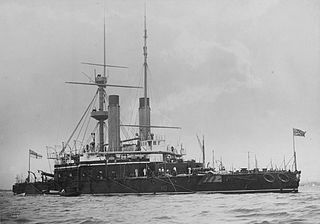
HMS Nile was one of two Trafalgar-class ironclad battleships built for the Royal Navy during the 1880s. Late deliveries of her main guns delayed her commissioning until 1891 and she spent most of the decade with the Mediterranean Fleet. Nile returned home in 1898 and became the coast guard ship at Devonport for five years before she was placed in reserve in 1903. The ship was sold for scrap in 1912 and broken up at Swansea, Wales.

HMS Hogue was a Cressy-class armoured cruiser built for the Royal Navy around 1900. Upon completion she was assigned to the Channel Fleet and the China Station. In 1906 she became a training ship for the North America and West Indies Station before being placed in reserve in 1908. Recommissioned at the start of World War I, she played a minor role in the Battle of Heligoland Bight a few weeks after the beginning of the war. Hogue was sunk by the German submarine U-9, together with two of her sister ships, on 22 September 1914.

HMS Repulse was one of seven Royal Sovereign-class pre-dreadnought battleships built for the Royal Navy in the 1890s. Assigned to the Channel Fleet, where she often served as a flagship, after commissioning in 1894, the ship participated in a series of annual manoeuvres, and the Queen Victoria's Diamond Jubilee Fleet Review during the rest of the decade. Repulse was transferred to the Mediterranean Fleet in 1902 and remained there until December 1903, when she returned home for an extensive refit. After its completion in 1905, Repulse was assigned to the Reserve Fleet until she was sold for scrap in 1911.

HMS Undaunted was one of seven Orlando-class armoured cruisers built for the Royal Navy in the mid-1880s.
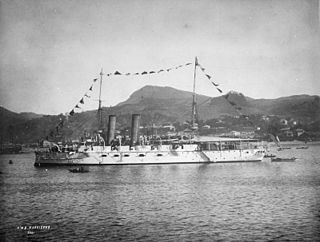
HMS Narcissus was one of seven Orlando-class armoured cruisers built for the Royal Navy in the mid-1880s. Future Admiral Ernest Gaunt served aboard her in 1896 as First Lieutenant. She was sold for scrapping on 11 September 1906.

HMS Immortalité was one of seven Orlando-class armoured cruisers built for the Royal Navy in the mid-1880s. She was sold for scrap on 11 January 1907.

HMS Aurora was one of seven Orlando-class armoured cruisers built for the Royal Navy in the mid-1880s. The ship spent a brief time in reserve before she was assigned to the Channel Squadron for two years in 1890. In 1893 Aurora became a coast guard ship in Ireland for two years before she was placed in reserve again. The ship recommissioned in 1899 for service on the China Station and some of her crew participated in the Battle of Tientsin in 1900 during the Boxer Rebellion. Aurora returned home two years later and was again reduced to reserve. She was taken out of service in 1905 and sold for scrap on 2 October 1907.
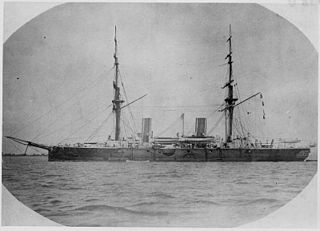
HMS Imperieuse was the lead ship of her class of two armoured cruisers built for the Royal Navy in the 1880s. She was sold for scrap in 1913.

The Nelson-class cruisers were a pair of armoured cruisers built in the 1870s for the Royal Navy.
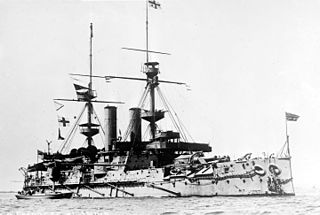
HMS Empress of India was one of seven Royal Sovereign-class pre-dreadnought battleships built for the Royal Navy during the 1890s. The ship was commissioned in 1893 and served as the flagship of the second-in-command of the Channel Fleet for two years. She was transferred to the Mediterranean Fleet in 1897, during which time Empress of India was assigned to the International Squadron blockading Crete during the uprising there. She returned home in 1901 and was briefly assigned as a coast guard ship in Ireland before she became the second flagship of the Home Fleet. The ship was reduced to reserve in 1905 and accidentally collided with the submarine HMS A10 the following year. Empress of India was taken out of service in early 1912 and accidentally struck a German sailing ship while under tow. She was sunk as a target ship in 1913.

HMS Cyclops was the lead ship of the Cyclops-class breastwork monitors built for the Royal Navy during the 1870s. The ships were ordered to satisfy demands for local defence during the war scare of 1870, but the pace of construction slowed tremendously as the perceived threat of war declined. The ship spent most of her career in reserve; her only sustained period in commission was four months in Portland Harbour, during the Russo-Turkish War in 1878 when the British were trying to force the Russians to end the war without allowing them to seize Constantinople. Cyclops was sold for scrap in 1903.

HMS Isis was an Eclipse-class protected cruiser built for the Royal Navy in the mid-1890s.
